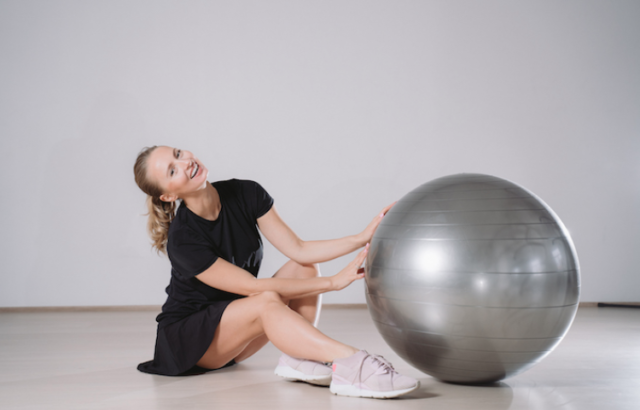The whole truth about the fitball Read before you buy it

Fitball is a truly unique projectile. Judge for yourself – both babies from 2 weeks of age and the elderly can engage in it. This is practically the only simulator that simultaneously involves vestibular, motor, tactile and visual analyzers, which greatly enhances the training effect.
There are so few contraindications that even people with various injuries can afford training.
But at first it was just a toy …
From toy to trainer
In 1963, the Italian Aquilino Kosani, the owner of a small toy factory, began to produce large-diameter balls. Products differed in the increased durability, thanks to improved casting of polyvinylchloride.
Physiotherapists became interested in the toy. English and Swiss specialists began to use large balls in programs for newborns and infants, and in work with children suffering from cerebral palsy. In the 80s, visiting clinics in Europe, Americans learned about fitball and began to successfully use it in the rehabilitation of patients with injuries of the musculoskeletal system.
Doctors noted that patients improved blood and lymph circulation, metabolism in the intervertebral discs, and tissue regeneration accelerated. The healing effect was so obvious that the scope of the ball began to grow rapidly. Now this affordable inexpensive projectile can be found not only in gyms, but also in many homes.
The universal benefits of fitball
- Classes on the fitball correct the curvature of posture, create optimal conditions for working out large muscle groups and involve various muscle groups.
- Coordination of movements improves flexibility increases – an unstable ball forces you to constantly keep your muscles in tension to maintain balance, and a round shape – to perform movements with a greater amplitude.
- Improves microdynamics and blood circulation in the intervertebral discs – due to the vibration and shock-absorbing function of the ball.
- The round shape of the ball reduces the load on the lower limbs. Thanks to this, even people with damaged knee and ankle joints, with varicose veins, and overweight can do fitness gymnastics.
How to choose the right fitball
When choosing a ball, consider the height and length of the arm from the shoulder (spit) to the tips of the middle finger of the hand. Another choice parameter: sitting on the ball, the hips should be parallel to the floor or 2-4 cm below the imaginary horizontal drawn through the highest point of the thigh.
Who should not train on a fitball
A short list of contraindications is another advantage of the fitball. It is not recommended to use the fitball for patients with serious pathologies of the cardiovascular system and internal organs, as well as those suffering from intervertebral hernias.
Otherwise, with a properly designed complex, people of different ages and different degrees of physical fitness can train with a fitball.
Fitball has become so popular and affordable that you can practice with it not only in special studios but also at home, online. Moreover, the home format of classes is becoming more and more popular. In the 20 minute program, Anastasia demonstrates effective exercises for balance, muscles of the arms, legs, buttocks and core muscles. Nastya focuses on the technique of performing the exercise and proper breathing, warns of possible mistakes.
Depending on the level of preparation, it is recommended to modify the exercises. If the load needs to be reduced, the amplitude and pace of the exercises are reduced. It is necessary to complicate – you can increase the pace / amplitude, take dumbbells or put on weights.
It is important to follow the instructions of the trainer, carefully monitor the core – in all exercises , the press works constantly. Nastya warns: only correctly performed exercises guarantee the desired result – strengthening muscles, improving posture, coordination, and a general healing effect.